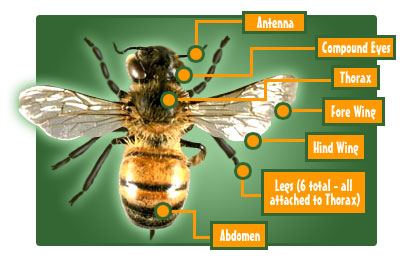Insect Anatomy
Information | Science
Insects hold a very unique - though very understandable - anatomy which is one of the better ways to understanding them in whole.

Insects are part of an animal group known as 'arthropods'. Arthropods are known as such in that they utilize hard protective exterior cases known as an 'exoskeleton'. Arthropods contain a host of well-known multi-legged creatures including arachnids (spiders), millipedes and crustaceans (ocean lobsters and crabs).
This exoskeleton makes up the entire surface of the insect's body, put together by separate plates meeting the joints of the body and legs. Arthropods do have muscles within the exoskeleton, but the muscles attach to the exoskeleton itself (as opposed to muscles attaching to ligaments and tendons, which attach themselves to bones in a human body. Movement is accomplished through these moving muscles, which in turn, move the plated exoskeleton parts. Exoskeletons are primarily made of a substance known as 'chitin', which is comparable to our real-world plastic. This substance is made to be 'self-libricated' to prevent the surface of the insect from drying out.
Basic Parts of an Insect
There a three basic parts to an insect - the head, thorax (the central portion of the body) and abdomen (the ball typically seen on many insects).
The head of an insect is where the main receptor parts are located. Typically, you will find the eyes, mouthparts constituting the mouth and biting parts (which also serve to guide food into the mouth), and a pair of antennae, which are sensory organs that allow the insect to use it's smell, taste, touch and 'hearing' abilities. The head of the insect is the most powerful part of it's body and is built from several connecting plates. The eyes of an insect are known as 'compound eyes' meaning that they are made up of several smaller eyes functioning in unison.
The thorax, or mid-section, typically holds the wings (if the insect can fly), usually two pairs (for a total of 4 wings) and 3 sets of legs (for a total of 6 legs). The thorax is also the central location of the more powerful muscles used in operating the wings and legs of the insect. The wings of most insects are setup with a support structure of thickened veins. The pattern of these veins varies from insect to insect. The feet-tips of insects will usually contain sticky pads, hooks or suckers of some type which allow the inset to cling to various types of surfaces or to clasp on to it's prey.
The abdomen makes up the last, and probably the most recognizable, part of the insect. This section of the body stores the bug's digestive system, reproductive organs and sting organs (if applicable). The abdomen is a reactive part of the insect body, meaning that it can expand when the insect feeds.
The body of an insect is does not mature like the body of a human does. The body of an insect must 'molt' or shed it's skin in an effort to grow. Once the insect has shed it's old skin, it then takes in air or water into it's new skin to 'blow' it up to it's new size. This must be done before the exoskeleton hardens once more, or else the insect will not grow into it's new larger size. Some insects have been know to molt over 20 times in their lifetime, but this process ceases when the insect has reached maturity in it's adult stage.
View details of Spider anatomy.
©InsectIdentification.org
Beetle Identification
Butterfly Identification
Caterpillar Identification
Spider ID
Fungal Infections on Insects
Nursery Web Spider
Official State Insects
Termite Basics
Insect Molting Process
Bugs of Tennessee
House Centipede
JoroSpider.org
2024 • Content ©2006-2024 InsectIdentification.org • All Rights Reserved. The InsectIdentification.org logo, its written content, and watermarked photographs/imagery are unique to this website (unless where indicated) and is protected by all applicable domestic and international intellectual property laws. Material presented throughout this website is for entertainment value and should not to be construed as usable for scientific research or medical advice (regarding bites, etc...).Please consult licensed, degreed professionals for such information. By submitting images to us (InsectIdentification.org) you acknowledge that you have read and understood our as it pertains to "User-Submitted Content". Images in JPG format are preferred with a minimum horizontal dimension of 1000px if possible. When emailing please include your location and the general estimated size of the specimen in question if possible. Please direct all inquiries and comments to insectidentification AT gmail.com. No A.I. was used in the generation of this content.
©2024 www.InsectIdentification.org • All Rights Reserved • Content ©2006-2024 (18yrs)

